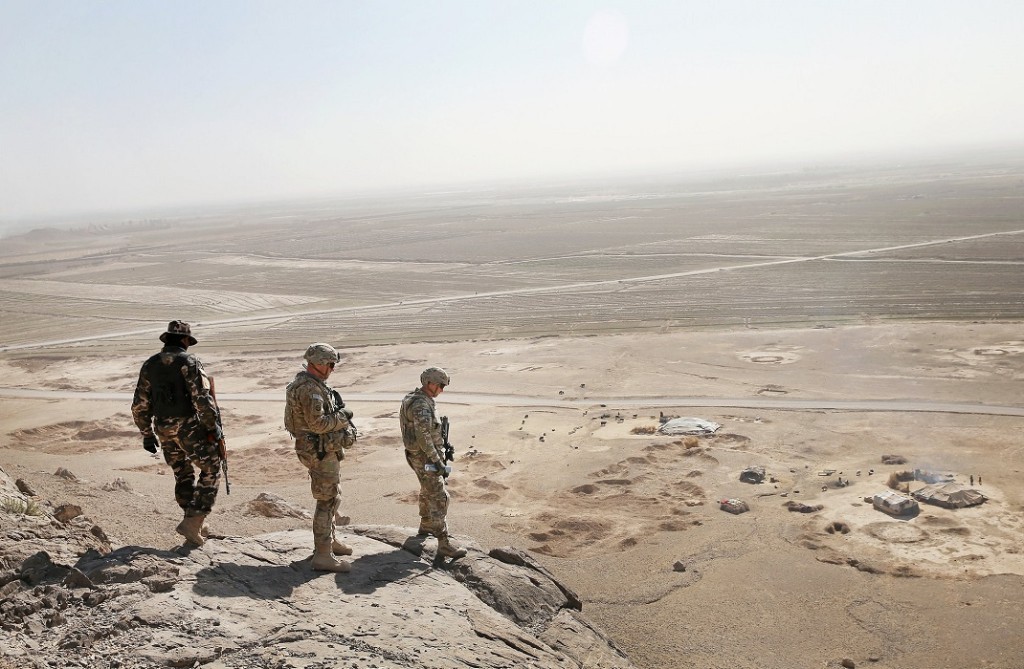
(NEW YORK TIMES) – President Obama, declaring that it was “time to turn the page on a decade in which so much of our foreign policy was focused on the wars in Afghanistan and Iraq,” announced on Tuesday that he planned to withdraw the last American troops from Afghanistan by the end of 2016.
Under a new timetable outlined by Mr. Obama in the Rose Garden, the 32,000 American troops now in Afghanistan would be reduced to 9,800 after this year.
That number would be cut in half by the end of 2015, and by the end of 2016, there would be only a vestigial force to protect the embassy in Kabul and to help the Afghans with military purchases and other security matters. At the height of American involvement, in 2011, the United States had 101,000 troops in the country.
Mr. Obama said the withdrawal of combat troops from Afghanistan would free up resources to confront an emerging terrorist threat stretching from the Middle East to Africa — a strategy he plans to detail in a commencement address on Wednesday at the United States Military Academy in West Point, N.Y.
“Americans have learned that it’s harder to end wars than it is to begin them,” he said. “Yet this is how wars end in the 21st century.”
Despite Mr. Obama’s attempt to signal the end of 13 years of American military engagement in Afghanistan, the United States will continue to have troops engaged in lethal counterterrorism operations there for at least two more years. The president also conceded that the United States would leave behind a deeply ambiguous legacy.
“We have to recognize Afghanistan will not be a perfect place, and it is not America’s responsibility to make it one,” he said. “The future of Afghanistan must be decided by Afghans.”
Republican critics in Congress said that even though Mr. Obama accepted the recommendation of his generals to leave behind a substantial residual force, the rigid deadline for the troops’ departure could expose Afghanistan to the same violence and instability that has erupted in Iraq since the pullout of the last American soldiers in 2011. Military commanders had recommended leaving at least 10,000 troops in Afghanistan for several years after the formal end of the combat mission in 2014.
Besides carrying out operations against the remnants of Al Qaeda, the troops that stay behind will train Afghan security forces. But from 2015 onward, they will be quartered at Bagram Airfield and in Kabul, the capital. While they will be supplemented by NATO troops, alliance members are likely to follow America’s lead in pulling out by the end of 2016.
The unilateral nature of Mr. Obama’s announcement underscored the loss of trust between him and President Hamid Karzai, who has refused to sign a long-term security agreement with the United States. Any American deployments after 2014 will hinge on the Afghans’ signing the agreement, Mr. Obama said, though he noted that both candidates in the runoff election to replace Mr. Karzai have promised to do so.
Mr. Obama briefed Mr. Karzai by phone Tuesday morning, as well as leaders of three NATO partners with troops in Afghanistan: Britain, Germany and Italy. On Sunday, Mr. Karzai declined an invitation to meet the president at the Bagram base, north of Kabul, where Mr. Obama had made an unannounced trip to greet the troops.
A senior administration official said Mr. Obama was encouraged enough by recent developments in Afghanistan, particularly the first round of the presidential race, to avoid the “zero option,” which would have meant pulling out all troops at the end of 2014.
“The priority for General Dunford and his team has been to keep as many troops as possible in Afghanistan for the 2015 fighting season,” said Jeremy B. Bash, a former chief of staff at the Pentagon, referring to the commander in Afghanistan, Gen. Joseph F. Dunford Jr.
The White House did not say how many of the troops remaining after 2014 would conduct counterterrorism missions, but it would most likely be a small fraction of the 9,800. The Central Intelligence Agency has gradually reduced its presence in the country as it turns its attention elsewhere, and some of the Afghan militias that the C.I.A. created to fight militants in the south and east are being quietly disbanded.
The president is clearly driven by a determination to shift the focus of his counterterrorism policy from Al Qaeda in Afghanistan and Pakistan to a more diffuse set of militant threats, some linked to Al Qaeda, that have sprung up from Syria to Nigeria.
On Wednesday, an official said, Mr. Obama will emphasize Syria’s growing status as a haven for terrorism and signal greater support for the opposition. Among the options on the table, officials said, is expanding the covert training program for rebels, currently run by the C.I.A. in Jordan — perhaps by bringing in the Pentagon to conduct the training.
The training could also take place in nearby countries. But the official cautioned that the president had not made a decision and was unlikely to discuss the matter in any detail at West Point. He is, however, expected to pledge greater American support for the counterterrorism efforts of Iraq, Jordan, Turkey and other countries that border Syria.
Mr. Obama’s Afghanistan announcement has ignited a broader debate about military strategy and the most effective way to wind down a war. A senior administration official said a fixed withdrawal schedule would provide NATO allies and the Afghans with “predictability” while also driving home the limits of the American effort.
“We never signed up to be a permanent security force in Afghanistan to fight against the Taliban,” said the official, who asked not to be identified under White House protocol for briefing reporters.
But some former military officers said that troop withdrawal decisions should be based on an assessment of the conditions on the ground, especially in a country as complex as Afghanistan.
The residual force is at the low end of what some military experts think is necessary to sustain operations. In 2015, the United States would be able to keep advisers at major Afghan regional military and police headquarters — a senior official described this as the “corps level” — but would not have advisers with tactical units on the battlefield.
Jack Keane, a retired general and vice chief of staff of the Army during George W. Bush’s administration, said the rigid timetable would hamper efforts to carry out counterterrorism operations and buttress the Afghan military effort. “Just arbitrarily pulling those forces out absolutely risks successful completion of the mission,” he said.
Some congressional critics said the deadline appeared to be driven by the political calendar: The last troops would be out 20 days before Mr. Obama leaves office in 2017, allowing him to claim success on one of his cardinal pledges in running for president.
“Holding this mission to an arbitrary egg-timer doesn’t make a lick of sense,” said Representative Howard McKeon of California, the Republican chairman of the House Armed Services Committee. “Does the president seek to replicate his mistakes in Iraq, where he abandoned the region to chaos and failed to forge a real security partnership?”
David S. Sedney, a former deputy assistant secretary of defense for Afghanistan, Pakistan and Central Asia, said the decision “gives on one hand (9,800) and takes away on the other hand (deadlines).”
Even defenders of Mr. Obama said they were concerned that the rapid pace of the drawdown would not preserve the security gains made in more than a decade of war in Afghanistan.
“Time will tell whether we can meet that standard at this pace,” said Michèle A. Flournoy, who was under secretary of defense for policy during Mr. Obama’s first term.
FONTE: NEW YORK TIMES













 e poi
e poi